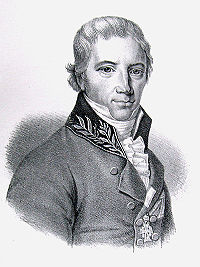
Christian Colbjørnsen
Encyclopedia

Background
Christian Colbjørnsen was born in SørumSørum
Sørum is a municipality in Akershus county, Norway. It is part of the traditional region of Romerike. The administrative centre of the municipality is the village of Sørumsand. Sørum was established as a municipality on 1 January 1838...
, Akershus
Akershus
- Geography :The county is conventionally divided into the traditional districts Follo and Romerike, which fill the vast part of the county, as well as the small exclave west of Oslo that consists of Asker and Bærum...
, in the traditional region of Romerike
Romerike
Romerike is a traditional district located north-east of Oslo, in what is today south-eastern Norway. It consists of the Akershus municipalities Fet, Lørenskog, Nittedal, Rælingen, Skedsmo, Sørum and Aurskog-Høland in the southern end , and Ullensaker, Gjerdrum, Nannestad, Nes, Eidsvoll and Hurdal...
, Norway
Norway
Norway , officially the Kingdom of Norway, is a Nordic unitary constitutional monarchy whose territory comprises the western portion of the Scandinavian Peninsula, Jan Mayen, and the Arctic archipelago of Svalbard and Bouvet Island. Norway has a total area of and a population of about 4.9 million...
. His parents were Colbjørn Colbjørnsen Jacobsen (1714–1761) and Anna Dorothea Røring (1710–1772). Along with his brothers, Jakob Edvard Colbjørnsen
Jakob Edvard Colbjørnsen
Jakob Edvard Colbjørnsen was chief justice of the Supreme Court of Denmark-Norway in the capital of Copenhagen....
(1744–1802) and Edvard Røring Colbjørnsen (1751–1792), Christian Colbjørnsen began at Christiania Cathedral School in February 1758. He left school at the end of 1763 without having completed the examination, probably because his father death. His relative Christian Petersen, who was Governor of Oppland
Oppland
is a county in Norway, bordering Sør-Trøndelag, Møre og Romsdal, Sogn og Fjordane, Buskerud, Akershus, Oslo and Hedmark. The county administration is in Lillehammer. Oppland is, together with Hedmark, one of the only two landlocked counties of Norway....
, took Christian in his house and gave him work in his office. In 1768, Petersen became Prefect of Bergen
Bergen
Bergen is the second largest city in Norway with a population of as of , . Bergen is the administrative centre of Hordaland county. Greater Bergen or Bergen Metropolitan Area as defined by Statistics Norway, has a population of as of , ....
. Christian followed him there and seems to have been there through the end of 1771.
Career
Christian Colbjørnsen became a key official in Denmark and Norway. He set clear traces in the work of the Danish peasant reforms 1786-88. He was a leading force behind much of the legislative work that Danish Chancellery initiated in 1790s. He has also been of great importance in shaping the Supreme Court's role in the Danish-Norwegian history in the early 19th century.From 1773, he served as lawyer and he was chamber attorney from 1780-1785. From August 1786, Colbjørnsen was secretary of the Rural Commission (Landbokommisjonen), a Danish committee appointed by then-Crown Prince Frederik, Regent of Denmark. The purpose of the Commission was to develop proposals for improvements in agriculture and set up clear guidelines for the relationship between landlords and peasants farmers.
In 1788 he was appointed president of work for the Chancellery
Chancellery
Chancellery is the office of the chancellor, sometimes also referred to as the chancery. Both of those words have other meanings as well.Chancellery can specifically refer to:...
and had great influence on Danish legislation. From 1804 until his death, Christian Colbjørnsen served as Chief Justice for the Supreme Court (Da. Højesteret, Nor. Høyesterett) located in the Danish-Norwegian capital, Copenhagen
Copenhagen
Copenhagen is the capital and largest city of Denmark, with an urban population of 1,199,224 and a metropolitan population of 1,930,260 . With the completion of the transnational Øresund Bridge in 2000, Copenhagen has become the centre of the increasingly integrating Øresund Region...
. Colbjørnsen was an energetic and authoritative leader of the Supreme Court who was an avid supporter of an enlightened autocracy.

